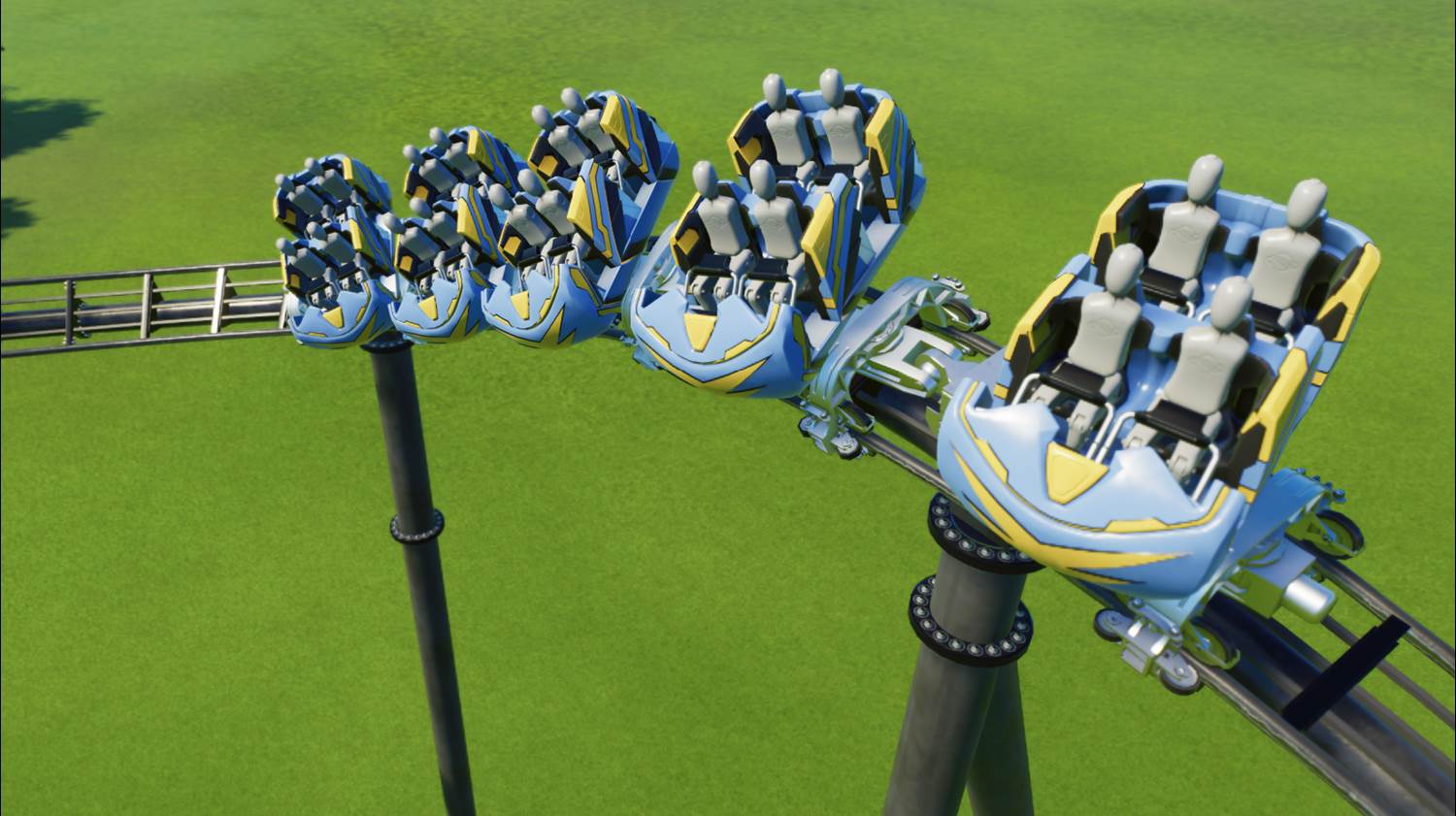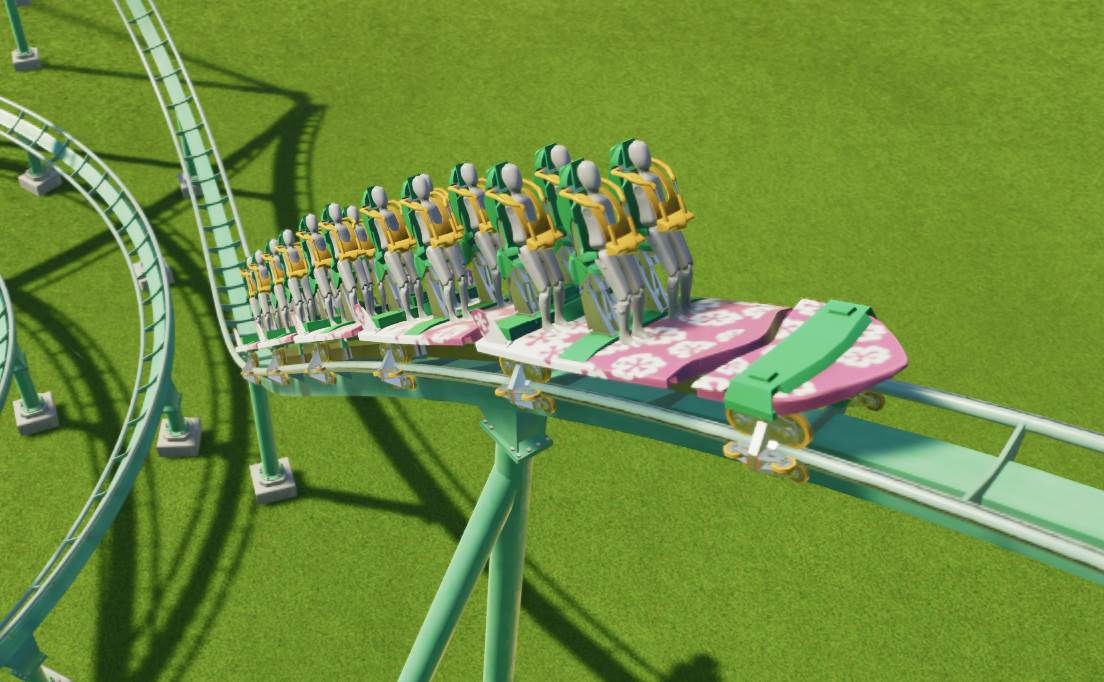The highly anticipated sequel to 2016’s Planet Coaster is finally here! With new ride systems (some inspired by the Disney Parks), water parks, and more, let’s take a look at this exciting new theme park simulation game.
Back in 2016, Planet Coaster was released on PC. For years, I watched YouTubers make incredible roller coaster creations as I saved up to buy a powerful gaming PC to try my hand at the theme park simulation game. Finally in 2018, I did it. I remember loading up the game for the first time, hearing that familiar music, and seeing King Coaster on my own computer. This is the game I had been waiting for, the true successor to RollerCoaster Tycoon 3. Perfectly mixing a whimsical aesthetic with realistic coaster designs, I spent hundreds of hours at my desk building the coasters of my dreams. Eight years later, Planet Coaster 2 is finally here. With brand new ride types, the addition of switch tracks, water parks, and advanced coaster customization, I have been itching for this day since the game was officially announced back in July. Today, I got a chance to check out the game, and I am so excited to share my thoughts on this dream of a game.
Loading into the game for the first time is very familiar. While there are some user interface upgrades, the game feels like a freshened up version of the original. I decided the best way to introduce myself to the game’s new offerings was to head into career mode, which offers a few tutorial scenarios for new and returning players. The set, titled First Drop, is the perfect place to refresh your building skills and navigate some of the game’s new functions.
Jumping into the first scenario, Keys to the Coaster, players are reunited with Eugene Newton and Oswald B Thompson as you begin your journey creating successful theme parks all around the world. With voice acting and visual prompts, navigating back into your coaster building prowess is a breeze.
First up, you are tasked with building a Teacup ride, similar to the Mad Tea Party at the Disney Parks. You’ll also be required to build a queue and decorate your ride, as well as construct prebuilt facilities for guests and staff. Again, most of this is very standard to the first game.
You’ll then be introduced to one of the game’s newest additions: Power. For most rides and facilities, players will now need to build generators, distributors, and connections to operate their theme park. The game eases players into this new function, however, players can no longer just plop down flat rides and open them up to guests. It adds a new layer of realism throughout scenarios that the previous game did not have. I’m unsure how much I love this new feature, but I imagine in harder scenarios it’ll be a fun challenge to balance the new logistic variable. Mechanics will, eventually, need to repair generators as the game progresses, so make sure you have enough staff to handle your park's attractions.
Afterwards, players will get to enjoy building their first roller coaster. While the game forces you to build a blueprint layout, you do get to decorate the attraction a bit before opening and advertising the new floorless coaster for guests. My favorite part of this initial scenario was getting to see one of the game’s new coaster types, which is based on the first generation Vekoma Tilt Coaster.
Now we really get to dive into Planet Coaster 2’s biggest addition, water parks.
Jumping into In the Swim of Things, players will once again meet with Newton and Thompson as well as a new character Brad Newton. Known as “the Water Guy,” Brad will walk you through building everything you need to operate a water park. First up, players will need to build changing rooms, a guest service station to sell passes for the water park, and a dryer. Then it’s time to build your first pool. I was shocked at how many guests quickly flooded into the pool before I was even onto the next step of the tutorial. Building pools is very similar to building paths, with different shapes and construction tools. Just like with the power system, players will also have to build water pumps and water filtration systems and connect them to pools throughout the water park. While I appreciate the commitment to accuracy, some of the new logistic functions began to overwhelm me as the game was introducing all of the new content. Players will also need to hire lifeguards, as guests do begin to “struggle” in the water occasionally.
The new flume building system works similarly to the coaster editor, allowing players to click and drag slide pieces to shape their creations. I had a lot of fun getting to explore this new side of the game, even if I think the water slide designs are a little clunky compared to their stellar coaster designs. However, this is the first time a theme park simulation game has included water parks since RollerCoaster Tycoon 3, and this game exponentially improved upon the 2004 game’s water park content.
The game also includes weather, something Planet Coaster didn’t have. Players will need to make sure there is shade and cover for hot and rainy days to keep guest satisfaction high.
After completing the tutorials, I decided it was time to check out the new ride systems in Sandbox Mode. This is where I think some of the game’s strongest additions lie. First up, I checked out the new Rotating Coaster. Inspired by Vekoma’s custom ride system for Guardians of the Galaxy Cosmic Rewind, I was really excited to try my hand at designing my own Omni-coaster. What’s so incredible about Planet Coaster 2 is, for the most part, designs are incredibly accurate. Guardians has an notably wide and unique looking track, and the game didn’t miss those details.
I will say that the new coaster building tools are far less intuitive than the previous game. With the game releasing on both PC and gaming systems, the new user interface was definitely designed to work for controllers in addition to keyboard and mouse. Within that, I found myself struggling to select track pieces to edit launch speeds when building. It was frustrating to have to switch between Construction and Edit mode to properly build my coaster. I’m sure with some practice, it’ll become more natural, but, for now, the coaster design tools felt really clunky and hard to navigate.
That wasn’t gonna stop me from checking out the other exciting coaster types found within the game. The new Multiverse Coaster model introduces switch tracks, drop tracks, and other unique elements previously unseen in the game, and they were so much for to play around with. Fans may recognize this coaster type as Thirteen at Alton Towers, the first coaster with a proper drop track. Intamin, who made Thirteen, also built Hagrid’s Magical Creature Motorbike Adventure, which also features a similar drop track. I cannot imagine the theming possibilities with this new ride type, and I hope as the game introduces new content they’ll introduce the track function to different coaster types. I would love to build a coaster with a swing launch.
Fans of Florida’s world class theme parks will also recognize the addition of a few familiar ride systems. Introducing a new log style for their flume ride, the new boats are nearly identical to those found on Tiana’s Bayou Adventure at Magic Kingdom. The previous game’s log ride, which featured vehicles modeled after Disneyland’s Tiana’s Bayou Adventure, also returned for the sequel. The possibilities are endless when it comes to building your favorite Disney attractions in Planet Coaster 2.
Also inspired by a famous Magic Kingdom attraction, the new Powered Rotating Ride is inspired by Disney’s Omnimover system used on Haunted Mansion. Featuring a slow, continuously moving ride system, building classic dark rides will be much easier in Planet Coaster 2.
The game also headed up I-4 for inspiration, introducing the Sit-Down Powered – 4 Seater ride system. Reminiscent of Islands of Adventure’s The High in the Sky Seuss Trolley Train Ride, the new ride system will allow players to build their own version of the relaxing Universal attraction.
Even hints of SeaWorld Orlando can be found throughout the game. The new Wave Coaster is inspired by B&M’s Surf Coaster, which is the ride system used for Pipeline at the aquatic theme park.
Within the game’s many successes, there are a few drawbacks to this sequel in comparison to Planet Coaster. The game did not carry over every ride system from the first game. A few of those offerings include Universal and Disney inspired designs, like the ride models reminiscent of the PeopleMover, Tower of Terror, and Harry Potter and the Forbidden Journey. I think it's a very strange choice to discard content when releasing a sequel to an already popular game. Hopefully, the developer Frontier will add these into Planet Coaster 2 in the future, but, for now, it seems like a huge miss to not include prior ride systems into the game.
My biggest gripe with Planet Coaster 2 is several inexcusable inaccuracies within returning coaster designs. The B&M Wing Coaster design returns from the first game with entirely different restraints. The first game accurately displayed the ride system’s vest restraints, however, Planet Coaster 2’s model features standard over the shoulder restraints instead.
They also did this to their Intamin Accelerator models, changing the thin over the shoulder restraints on their Kingda Ka inspired trains with standard over the shoulders with the lap bars on their Formula Rosa modeled trains also switching to standard over the shoulder restraints. I do not understand how the accurately depicted trains were botched this hard when being added to the sequel.
Bizarrely, the game still features the vest style restraint, including on their B&M Stand Up trains which actually just have standard over the shoulder restraints in real life and in the first game. I’m not sure what went wrong there.
I hope they fix this in the future because it feels like a huge oversight within the game’s design. I know it won’t negatively impact the casual player, but many hardcore players will notice these unfortunate missteps.
Overall, Planet Coaster 2 is mostly a home run. I think that, while the game does feel like more of an expansion pack, it is great to have a robust new library of content to build with. It is unfortunate that the game was designed to cater to console players, sacrificing a bit of the intuitive gameplay features for PC players. With time, I imagine the new gameplay will feel natural. Boasting an incredible list of strengths, it is just unfortunate that Planet Coaster comes with a few flaws nonexistent in Planet Coaster. The game is so close to being perfect that those little inconveniences and inconsistencies feel bigger. I still highly recommend picking up the game! Currently, the Standard Edition of Planet Coaster 2 runs for $49.99 with the Deluxe Edition retailing for $64.99. The game is available now on Steam, Epic Games, PlayStation, and Xbox.
Read More Video Games:





















